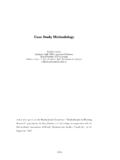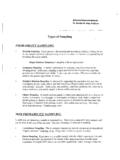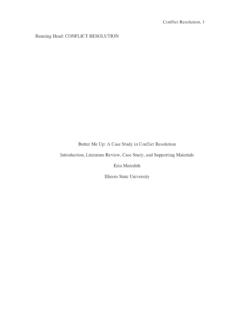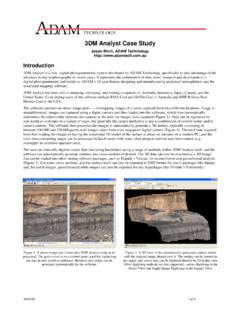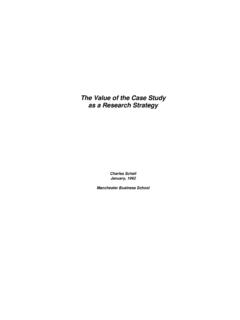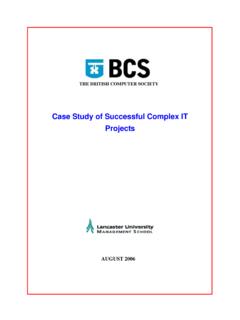Transcription of Case study as a research method - psyking.net
1 Jurnal Kemanusiaan , Jun 2007. case study as a research method Zaidah Zainal Faculty of Management and Human Resource Development Universiti Teknologi Malaysia Abstract Although case study methods remain a controversial approach to data collection, they are widely recognised in many social science studies especially when in-depth explanations of a social behaviour are sought after. This article, therefore, discusses several aspects of case studies as a research method . These include the design and categories of case studies and how their robustness can be achieved. It also explores on the advantages and disadvantages of case study as a research method . Introduction case study research , through reports of past studies, allows the exploration and understanding of complex issues.
2 It can be considered a robust research method particularly when a holistic, in-depth investigation is required. Recognised as a tool in many social science studies, the role of case study method in research becomes more prominent when issues with regard to education (Gulsecen & Kubat, 2006), sociology (Grassel & Schirmer, 2006) and community- based problems (Johnson, 2006), such as poverty, unemployment, drug addiction, illiteracy, etc. were raised. One of the reasons for the recognition of case study as a research method is that researchers were becoming more concerned about the limitations of quantitative methods in providing holistic and in-depth explanations of the social and behavioural problems in question.
3 Through case study methods, a researcher is able to go beyond the quantitative statistical results and understand the behavioural conditions through the actor's perspective. By including both quantitative and qualitative data, case study helps explain both the process and outcome of a phenomenon through complete observation, reconstruction and analysis of the cases under investigation (Tellis, 1997). Past literature reveals the application of the case study method in many areas and disciplines. Among them include natural examples in the fields of Sociology (Grassel & Schirmer, 2006), Law (Lovell, 2006) and Medicine (Taylor & Berridge, 2006). In addition, there are also other areas that have used case study methods extensively, particularly in government, management and in education.
4 For instance, there were studies conducted to ascertain whether particular government programmes were efficient or whether the goals of a particular programme were reached. In other examples, such as in education, evaluative applications were conducted to assess the effectiveness of educational programmes and initiatives. In these types of study , limiting to only quantitative method would obscure some of the important data that need to be uncovered. Definition of case study case study method enables a researcher to closely examine the data within a specific context. In most cases, a case study method selects a small geographical area or a very limited number of individuals as the subjects of study .
5 case studies, in their true essence, explore and case study as a research method investigate contemporary real-life phenomenon through detailed contextual analysis of a limited number of events or conditions, and their relationships. Yin (1984:23) defines the case study research method as an empirical inquiry that investigates a contemporary phenomenon within its real-life context; when the boundaries between phenomenon and context are not clearly evident; and in which multiple sources of evidence are used.. In some case studies, an in-depth longitudinal examination of a single case or event is used. The longitudinal examination provides a systematic way of observing the events, collecting data, analysing information, and reporting the results over a long period of time.
6 For instance, studies on child language development can be conducted using this longitudinal case study method . Data collected through observations are recorded to ascertain the language development of a child. In another example, a researcher conducting a case study may examine the reading processes of only one subject over a period of time. In other words, a case study is a unique way of observing any natural phenomenon which exists in a set of data (Yin, 1984). By unique it is meant that only a very small geographical area or number of subjects of interest are examined in detail. Unlike quantitative analysis which observes patterns in data at the macro level on the basis of the frequency of occurrence of the phenomena being observed, case studies observe the data at the micro level.
7 Design of case study Since case study method receives criticism in terms of its lack of robustness as a research tool, crafting the design of case studies is of paramount importance. Researchers can adopt either a single- case or multiple- case design depending on the issue in question. In cases where there are no other cases available for replication, the researcher can adopt the single- case design. For instance, a social study on the effects of the collapse of Highland Towers in Kuala Lumpur in the 1990s, or the effects of tsunami in Acheh in 2004 can be conducted using a single- case design, where events are limited to a single occurrence. However, the drawback of a single- case design is its inability to provide a generalising conclusion, in particular when the events are rare.
8 One way of overcoming this is by triangulating the study with other methods in order to confirm the validity of the process. The multiple- case design, on the other hand, can be adopted with real-life events that show numerous sources of evidence through replication rather than sampling logic. According to Yin (1994), generalisation of results from case studies, from either single or multiple designs, stems on theory rather than on populations. By replicating the case through pattern-matching, a technique linking several pieces of information from the same case to some theoretical proposition (Campbell, 1975), multiple- case design enhances and supports the previous results.
9 This helps raise the level of confidence in the robustness of the method . For instance, research on dyslexic children with reading problems requires a number of replication that can be linked to a theory before conclusive results are generalised. Careful design of a case study is therefore very important. This is because case study method , through interviews or journal entries, must be able to prove that: i. it is the only viable method to elicit implicit and explicit data from the subjects ii. it is appropriate to the research question iii. it follows the set of procedures with proper application iv. the scientific conventions used in social sciences are strictly followed v.
10 A chain of evidence', either quantitatively or qualitatively, are systematically recorded and archived particularly when interviews and direct observation by the researcher are the main sources of data vi. the case study is linked to a theoretical framework (Tellis, 1997). 2. Jurnal Kemanusiaan , Jun 2007. Category of case study There are several categories of case study . Yin (1984) notes three categories, namely exploratory, descriptive and explanatory case studies. First, exploratory case studies set to explore any phenomenon in the data which serves as a point of interest to the researcher. For instance, a researcher conducting an exploratory case study on individual's reading process may ask general questions, such as, Does a student use any strategies when he reads a text?
